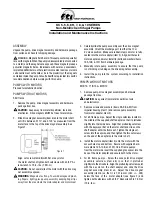
14
228-1692 REV 8
090418
KEPCO, INC.
131-38 SANFORD AVENUE
FLUSHING, NY. 11355 U.S.A.
TEL (718) 461-7000
FAX (718) 767-1102
http://www.kepcopower.com
email: [email protected]
WARNING
Accessing the BOP after the output
is disabled in BATTERY mode is
hazardous because (1) high current
arcing is possible and (2) either the
external battery voltage, or the volt-
age (±Voltage Protection max) on
the BOP output terminals may be
dangerous. Therefore, for battery
and constant-voltage-type active
electronic loads it is recommended
that two properly rated external
switches be installed for safety:
one in series with the battery, and
one across the BOP output. After
the unit is set to OFF, first open the
switch in series with the battery,
then close the switch across the
BOP output to ensure safety before
handling BOP connections. When
connecting the battery, the switch
across the output should be
opened after the connections are
complete and then the switch in
series with the battery should be
closed. If the constant-voltage-type
active electronic load is adjusted to
zero before handling the power
supply-to-load connections, only
the switch across the BOP output
is required.
Battery
. This mode is necessary for the power sup-
ply to function properly and safely with either battery
or constant-voltage-type active electronic loads. This
mode prevents the battery from discharging during
the OFF state. When the output is disabled (set to
OFF), the BOP will go to current mode, current will
be set to zero, with voltage protect and current limit
set to maximum. In this way the battery will not be
discharged while the output is OFF. For constant-
voltage-type active electronic loads this mode stops
energy flow during the OFF state. Table 5 indicates
how the power supply responds to a command to go
from Output ON to OFF.
CONFIGURE LOAD TYPE.
To configure, press
%
from the power-up screen, then highlight Load
Type and press
!
to modify. (If a Password is
required, see Operator’s Manual for instructions.)
Highlight Active, Resistive or Battery (see explana-
tions and associated WARNINGS above) and press
$
to save. Then press
$
to save for power-up,
#
to abort, or
%
to apply the changes (without
saving for power-up) and exit. After configuring, the
new setting will be effective when the power supply
goes from output on to output off.
To restore factory default (Active), press
%
from the
power-up screen, highlight Load Type, press
!
,
then press
@
to restore default. Press
$
to save
for power-up or
%
to exit
ENABLING/DISABLING OUTPUT POWER.
The BOP output can be disabled (OFF) or enabled
(ON) by toggling the
STANDBY
key in local mode.
The behavior of the unit when disabled depends on
the Load Type setting (See “Max/Min Setting Menu”
on page 13. 6 and Table 5 for details).
IX — ADDITIONAL FEATURES.
The user is urged to refer to the Operator’s Manual
for full explanations all BOP 1KW features, includ-
ing:
•
Passwords - three independent levels of
access
•
Changing the Default Power up Settings
•
Digital Remote Operation - using SCPI com-
mands via RS 232, GPIB or LAN ports; opera-
tion via web pages
•
Analog Remote Operation - via Analog I/O
port
•
Details about Protect Limits and Software-
controlled limits
•
Storing/Recalling Power Supply Output Set-
tings
•
Waveform Generation - Sine, Triangle,
±Ramp, Square and Level segments. Local
operation allows up to 16 waveforms, maxi-
mum 10 segments per waveform. Remote
operation allows 1 waveform, maximum of
126 segments, or using LIST commands.
•
Operator Testing
•
Calibration - via either local keypad or remote
SCPI commands
•
Parallel/Series Configurations -increase cur-
rent capability, voltage capability, or both.


































